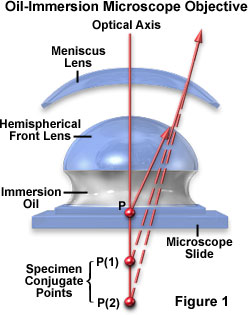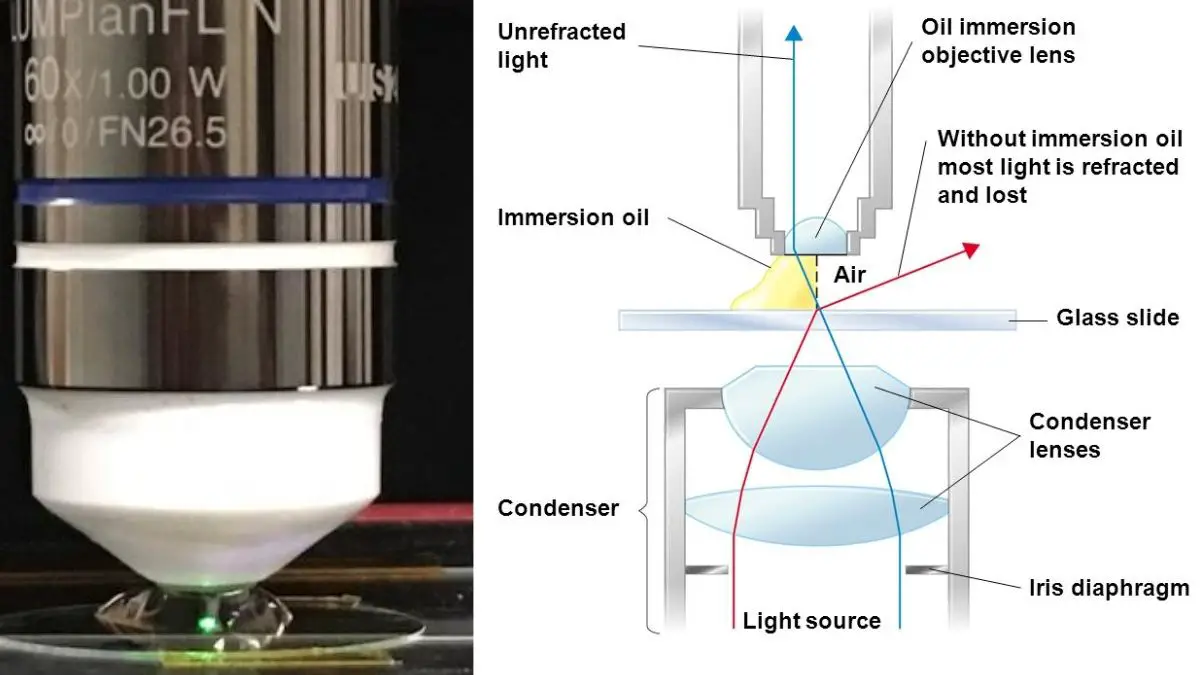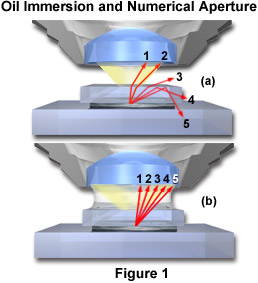oil immersion
The best resolution is achieved when the space between the. Browse Immersion oil and related products at MilliporeSigma.
Elevated temperatures can be due to substage illuminators hot stage or other causes ideal situations for Cargille Immersion Oil Type 37.

. Be sure that your sample is. One or more synthetic oils are preferred over the former use of natural oils commonly derived from cedar-wood or sandalwood. A disadvantage of oil immersion viewing is that the oil must stay in contact and oil is viscous.
Immersion oil can and will penetrate the microscope components and can damage dry objectives as immersion oil can corrode the cement used to hold objective front lenses in place. Remove excess oil using a lens cleaning tissue with a single sweep across the lens. This is still considered as the best alternative for synthetic oils.
It is nearly impossible to view living motile protists at a magnification of 1000x except for the very smallest and slowest. Immersion oil contributes to the homogeneous path of light between the condenser and objective by having the same index as the glasses in the system. Solving Problems In Life Science By Collaborating With the Global Scientific Community.
This has the effect of increasing the numerical aperture of the objective lens meaning that the lens can gather more light despite its small size. There are several types of immersion oils present in the market today. Microscope Immersion Oil Type A 12 Oz 15 mL in an Easy-to-Use Amber Glass Dropper Bottle.
Most objectives in the magnification range between 60x - 100x are designed for use with immersion oil. The Cedar Wood Oil. Place your sample on the microscope stage and center it using the 4x objective.
It is related to the depth of field which is the. Immersion oil can and will penetrate and damage microscope components and objectives not suited for immersion. To clean your immersion objective use a lens cleaning tissue to sweep across the surface of the objective front lens in one direction only.
The large NA of these objectives and correspondingly high angular aperture μ in Equation 1 above result in quite short working distances which is the distance from the top lens of the objective to the closest surface of the sample. How to Use Microscope Immersion Oil Begin by focusing your sample using the 40x objective lens. One way of increasing the optical resolving power of the microscope is to use immersion liquids between the front lens of the objective and the cover slip.
Immersion oil is the microscopy hack to reach a numerical aperture higher than the theoretical limit of air. Now carefully set the 100x objective lens on. Rotate the objective lens part way between the 40x and 100x.
FREE Shipping on orders over 25 shipped by Amazon. Oil immersion is essential for viewing individual bacteria or details of the striations of skeletal muscle. Keep wiping the objective front lens with a clean piece of tissue for each wipe until no trace of oil remains.
The cedarwood oil has been in use for microscopy for much longer than any other type. Oil immersion objectives are not ideal for imaging deep within a sample or with thick samples. Gradually moving up in magnification allows you to.
Solving the problem of image degradation above the standard calibration temperature of 23C. The place a drop of type A immersion oil at the top of the coverslip. Immersion oil Technique After observing the sample in 40x rotate the objective lens partway between the 40x and 100x lens.
46 out of 5 stars. We have mentioned the most used immersion oils for microscopy. Oil Immersion Lens Technique 1.
But this type of oil has several disadvantages. White light however is composed of many wavelengths. Once centered gradually work your way up through the objectives.
The placing of a body under water or other liquid. Eliminate toxicity and disposal problems with the Epredia Resolve immersion oil which contains no PCBsVWR offers a broad line of reagent droppers diagnostic kits and antigens and antisera for aid in identifying a variety of microscopic organisms. In addition researchers scientists school labs and hobbyists can order a mixture of different oils to achieve a specific viscosity.
It has been used for many years to increase the magnification and see the detail of some of the most elusive and small microorganisms. Get it as soon as Wed Jul 7. Place a drop of immersion oil on the top of your cover slip and another drop directly on.
Oil immersion is a special technique used in light microscopy that involves the immersion of both the specimen and the objective lens in a transparent oil that has a high refractive index. For use with Oil Immersion objectives Available in both high and low viscosities PCB free Non-drying non-hardening Resolve immersion oil is a clear colorless oil refractive index. 15150 that allows light transmission through most of the UVVIS spectrum.
Oil Immersion and Refractive Index. Ad Expertise On Every Level To Craft Science Technology Solutions In Life Science. The visualization of bacteria by means of staining procedures is an important tool for any microbiologist to have at their.
Microscopyfilling the space between the objective lens and the top of the cover glass with a fluid such as water or oil to reduce spheric aberration and increase effective numeric aperture by elimination of refractive effects that result from an air-glass interface. Developed specifically for working at human body temperatures Type 37 has a refractive index of 1515 and a viscosity of 1250 cSt at 37C. Good results have been obtained with an oil that.
Oil immersion at its most ideal includes a similar Ph between glass and oil.

Oil Immersion Java Tutorial Olympus Ls

Oil Immersion Technique Objectives Resolving Power Used For Types

Immersion Objectives Using Oil Glycerol Or Water To Overcome Some Of The Limits Of Resolution Science Lab Leica Microsystems

Molecular Expressions Microscopy Primer Anatomy Of The Microscope Immersion Media

Amazon Com Amscope Ml A A Microscope Immersion Oil 1 4 Oz Electronics

Oil Immersion Microscopy Animation Youtube

Extending The Limits Oil Immersion Flow Microscopy Labcompare Com


0 Response to "oil immersion"
Post a Comment